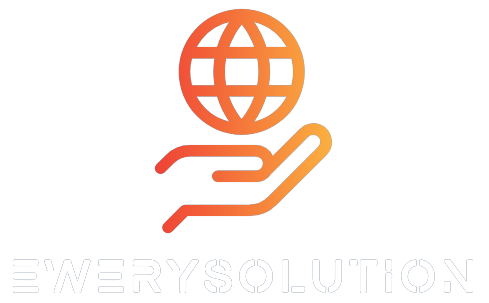EWERYSOLUTION
# **How to Do Search Engine Optimization: A Step-by-Step Guide**
## Introduction to Search Engine Optimization (SEO)
Search Engine Optimization (SEO) is the key to improving your website's visibility on search engine results pages (SERPs) and driving organic traffic to your site. In this comprehensive guide, we will explore essential SEO strategies that can help your website rank higher and attract more potential customers.
## Understanding the Importance of SEO
In today's highly competitive online landscape, standing out from the crowd is no easy task. SEO plays a crucial role in enhancing your online visibility and making your website more discoverable to users searching for products or services related to your niche. By optimizing your website for search engines, you increase the chances of attracting organic traffic and gaining a competitive edge.
## Keyword Research and Analysis: The Foundation of SEO
. Use keyword research tools to find relevant, rankable keywords that have a healthy balance of search volume and competition. Incorporate these keywords naturally into your content to improve your website's chances of ranking higher on search engine results.
## On-Page SEO Techniques: Optimizing Your Content
On-page SEO involves optimizing individual web pages to improve their search engine rankings. Here are some essential on-page techniques:
### Title Tags and Meta Descriptions
Craft compelling title tags and meta descriptions that include your target keywords. These elements provide users with a glimpse of your content in search results and can significantly impact click-through rates.
### URL Structure and Navigation
Ensure your website's URL structure is clean, descriptive, and easily understandable. User-friendly navigation enhances the user experience and helps search engines index your site more efficiently.
### Heading Tags and Keyword Placement
Use proper heading tags (H1, H2, H3) to organize your content and signal its structure to search engines. Strategically place your target keywords within the headings and body text.
### Image Optimization
Optimize images with descriptive alt text and relevant filenames. Image optimization not only improves accessibility but also presents additional opportunities for keyword inclusion.
### Internal Linking
Internal links help search engines navigate and understand your website's content hierarchy.
## Off-Page SEO Strategies: Building Authority and Trust
Off-page SEO focuses on activities that occur outside your website but can significantly impact your search rankings. Consider the following off-page strategies:
### Link Building
Earning high-quality backlinks from authoritative websites is one of the most crucial aspects of off-page SEO. Natural and relevant backlinks signal search engines that your content is valuable and trustworthy.
### Social Media Marketing
Leverage social media platforms to promote your content and engage with your audience. Social signals can indirectly influence your search engine rankings.
### Guest Blogging
. Guest blogging not only expands your reach but also provides opportunities for backlinks to your website.
### Influencer Outreach
Collaborate with influencers and industry experts to promote your brand and content. Influencers can help amplify your message and attract new audiences.
## Technical SEO Optimization: Ensuring Smooth Website Performance
Technical SEO involves optimizing the technical aspects of your website to enhance its search engine visibility. Focus on the following:
### Site Speed and Performance
A fast-loading website provides a better user experience and is favored by search engines. Compress images, minify CSS and JavaScript, and use caching to improve site speed.
### Mobile Responsiveness
Given the increasing number of mobile users, a mobile-responsive website is critical. Ensure that your site is mobile-friendly and provides seamless user experiences across devices.
### Secure HTTPS Protocol
Switch to HTTPS to encrypt data transmission and enhance user security. Search engines prioritize secure websites in their rankings.
### XML Sitemap and Robots.txt
Create and submit an XML sitemap to help search engines crawl and index your site efficiently. Use robots.txt to control search engine bots' access to specific areas of your website.
## Local SEO for Small Businesses: Targeting Local Audiences
For small businesses targeting specific geographic areas, local SEO is paramount. Consider the following local SEO techniques:
### Google My Business
Optimize your Google My Business listing with accurate and up-to-date information. This improves your chances of appearing in local search results and Google Maps.
### Local Citations
Ensure consistent business information across online directories to enhance local search visibility.
### Customer Reviews and Testimonials
Positive customer reviews build trust and credibility, ultimately boosting your local search rankings.
## Measuring and Tracking SEO Success: Data-Driven Insights
To gauge the effectiveness of your SEO efforts, use tools like Google Analytics and Google Search Console. Monitor key performance indicators (KPIs) such as organic traffic, bounce rate, and conversion rates. Use these insights to refine your SEO strategy continually.
## Avoiding Common SEO Mistakes: Best Practices to Follow
To maintain a healthy and effective SEO strategy, avoid common pitfalls, such as keyword stuffing, duplicate content, and using black hat SEO techniques. Focus on creating valuable, user-centric content that aligns with search intent.
## The Future of SEO: Embracing Emerging Trends
SEO is a dynamic field that continually evolves with changes in technology and user behavior. Stay ahead of the curve by embracing emerging trends such as voice search, artificial intelligence, and featured snippets.
## Conclusion
Implementing a well-rounded SEO strategy is a game-changer for your online presence. By understanding the importance of SEO, conducting thorough keyword research, and optimizing your website using on-page, off-page, and technical SEO techniques, you can increase your search engine rankings, drive organic traffic, and achieve sustainable online success.
---




0 Comments